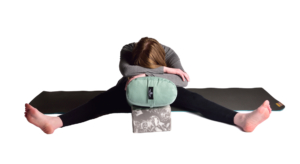This entry was posted on Feb 26, 2024 by Charlotte Bell.

Most of us would probably agree that our lives are filled to the brim. When we’re super busy, what often drops off our schedule are the very things we need most, like our yoga practice. Running through a few quick Sun Salutations (Surya Namaskara) is certainly better than no practice, but it won’t necessarily sustain and restore your energies. We also need rest to balance busyness. Standard Yoga Bolsters are one of the key tools for calming agitation and renewing our energies.
B.K.S. Iyengar originally developed Restorative Yoga as a therapeutic practice to heal specific physical imbalances and to regenerate spent energy. Restorative Yoga specialist Judith Hanson Lasater learned about restorative practice directly from Mr. Iyengar. She has since developed and refined the practice and now teaches workshops and trainings worldwide.
What sets Restorative Yoga apart is that all its asanas are supported. Restoring our energies requires that we spend as little energy as possible. Setting up poses with Yoga Bolsters, Blankets, Blocks and Straps allows our bodies to be completely supported. Then we can simply relax and breathe without expending our energies.
Essential Tools for Restorative Yoga
Probably the best investment you’ll ever make for your Restorative Yoga practice is a yoga bolster. Hugger Mugger originally designed their Standard Yoga Bolsters in the 1980s, according to specs from the Ramamani Iyengar Memorial Yoga Institute in Pune, India. One of the Standard Yoga Bolster’s unique features is its flat surface. This makes these bolsters comfortable and stable in many poses.
The size, shape and combination of surface softness with a solid core make these bolsters very versatile. They are soft and comfy, but also stable and supportive. These yoga bolsters are handmade in Hugger Mugger’s Salt Lake City facility, and I can vouch for the fact that they will give you years, if not decades, of service. I still have—and use—bolsters from the very first batch made in the 1980s!
3 Ways to Use Standard Yoga Bolsters
Here are three poses that will help familiarize you with the joys of Standard Yoga Bolsters:
Supported Supta Baddhakonasana (Bound Angle Pose)
The picture at the top of this blog may be the best-loved pose in the restorative canon—at least by my own students. This pose confers many benefits. It can ease abdominal distress and is unsurpassed for general relaxation. Neither a backbend nor forward bend, it has a neutral effect on your spine. Like all restorative poses, you can improvise with the props you have. For example, you can use just the standard bolster and the block that’s holding it up, along with either the blocks under the knees or the strap. If you don’t have extra blankets on hand, you can let your arms rest on the floor. The essential parts for this version of the pose are: the Standard Yoga Bolsters, supported by a Yoga Block; several Yoga Blocks or a Yoga Strap to support the leg position. For more info on setting up this pose, visit this blog.
 Supported Upavista Konasana (Seated Angle Pose)
Supported Upavista Konasana (Seated Angle Pose)
Seated forward bends are inherently relaxing—unless your hamstrings are tight. Seated forward bends are most beneficial when you’re able to rest. When your body is just hanging out in space with no support, the effort to resist gravity actually spends, rather than restores, energy.
A slanted Standard Yoga Bolster can provide support that allows for complete relaxation. Feel free to pile blankets on top of the bolster if it’s not high enough. Also, sitting on an extra folded blanket can help tilt your pelvis forward for a healthier forward bend. If your head doesn’t reach the bolster, even with extra blankets on top, no problem. Simply rest your arms on the bolster. Any support that lessens your resistance to gravity will help you relax. Here’s a post that explains restorative forward bends in more detail.
 Supported Savasana (Corpse Pose)
Supported Savasana (Corpse Pose)
Many people need extra support when lying supine. The right support under the knees can make the difference between a restless Savasana and a peaceful one. There are many ways to create this support, of course. But I have a crush on this way of setting up that I learned the last time I studied restorative practice with Judith Lasater. I like it because the legs are supported evenly. There’s no part of the leg that’s pressing too firmly into the bolster or blanket. All you need for this is a Standard Yoga Bolster, a Yoga Block and a rolled-up blanket or Pranayama Bolster (as shown in the photo). If you want more detail, read this post.
Note that while there are plenty of poses that utilize a bolster lying flat on the floor, the three I’ve chosen all employ a ”bolstered” bolster. By that, I mean the Standard Yoga Bolster is slanted using the support of a block underneath. Hugger Mugger’s bolsters are uniquely suited for these poses because of their solid core that doesn’t collapse when you slant them over a block.
About Charlotte Bell
Charlotte Bell discovered yoga in 1982 and began teaching in 1986. Charlotte is the author of Mindful Yoga, Mindful Life: A Guide for Everyday Practice and Yoga for Meditators, both published by Rodmell Press. Her third book is titled Hip-Healthy Asana: The Yoga Practitioner’s Guide to Protecting the Hips and Avoiding SI Joint Pain (Shambhala Publications). She writes a monthly column for CATALYST Magazine and serves as editor for Yoga U Online. Charlotte is a founding board member for GreenTREE Yoga, a non-profit that brings yoga to underserved populations. A lifelong musician, Charlotte plays oboe and English horn in the Salt Lake Symphony and folk sextet Red Rock Rondo, whose DVD won two Emmy awards in 2010.

